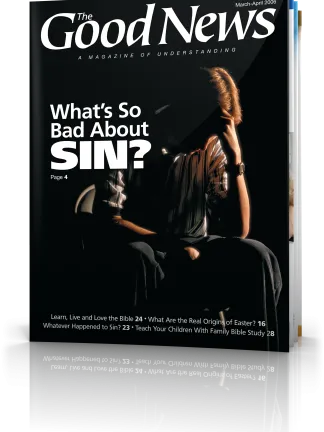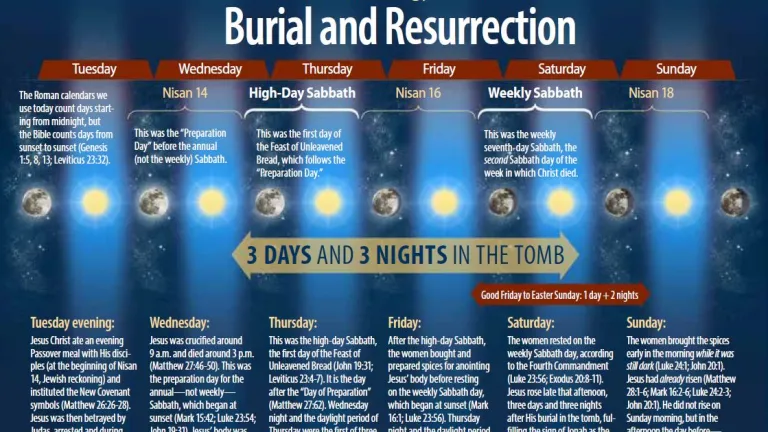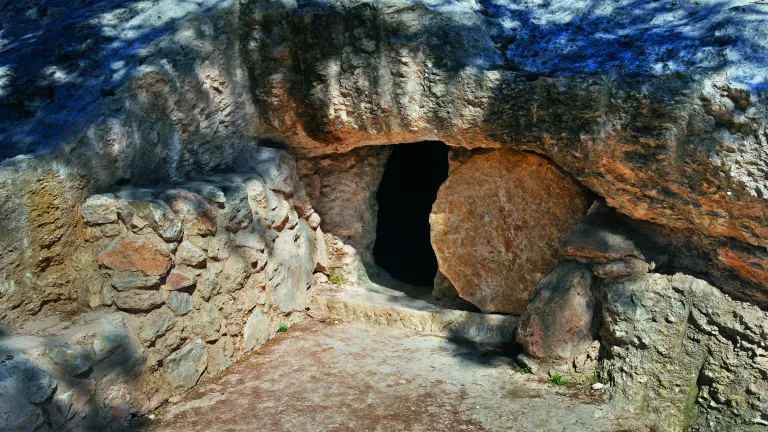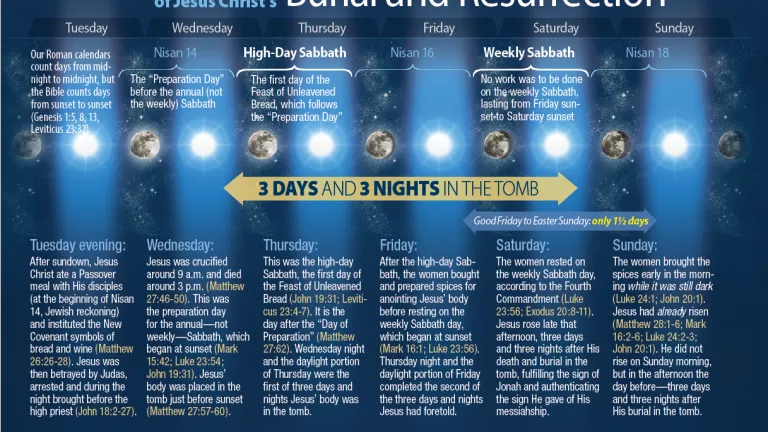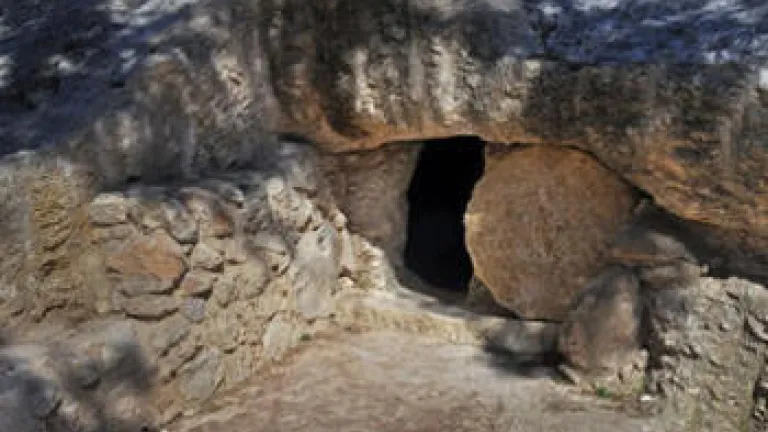Jesus Wasn't Crucified on Friday or Resurrected on Sunday: How long was Jesus in the tomb?
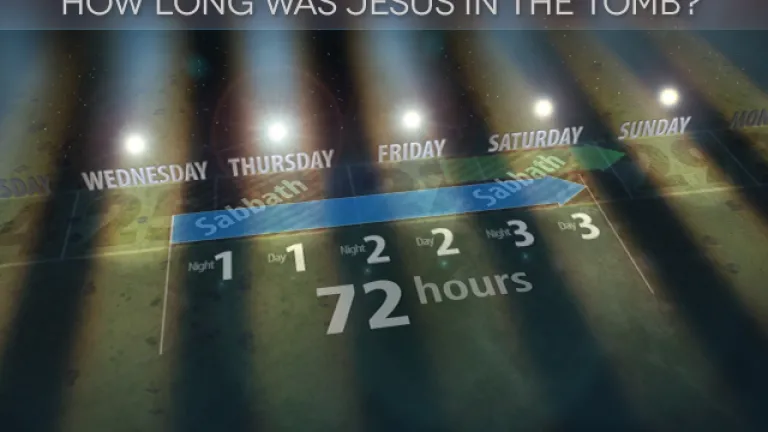
How can we fit three days and three nights between a Friday afternoon crucifixion and an Easter Sunday sunrise? The fact is, we can't. So what is the truth about when Jesus was crucified and resurrected? How long was Jesus Christ in the tomb?
About one billion Protestants and another billion Catholics believe that Jesus Christ was crucified and entombed on a Friday afternoon—"Good Friday"—and raised to life again at daybreak on Easter Sunday morning, a day and a half later.
Yet when we compare this to what Jesus Himself said about how long He would be entombed, we find a major contradiction. How long did Jesus say He would be in the grave? "For as Jonah was three days and three nights in the belly of the great fish, so will the Son of Man be three days and three nights in the heart of the earth" (Matthew 12:40).
The key to understanding the timing of Christ's crucifixion and resurrection lies in understanding God's timetable for counting when days begin and end, as well as the timing of His biblical festivals during the spring of the year when these events took place.
The context in which Jesus Christ said these words is important. The scribes and Pharisees were demanding a miraculous sign from Him to prove that He was indeed the long-awaited Messiah. "But He answered and said to them, 'An evil and adulterous generation seeks after a sign, and no sign will be given to it except the sign of the prophet Jonah'" (verse 39).
This was the only sign Jesus gave that He was the promised Messiah: "For as Jonah was three days and three nights in the belly of the great fish, so will the Son of Man be three days and three nights in the heart of the earth" (emphasis added throughout).
Traditional timing doesn't add up
The Gospels are clear that Jesus died and His body was hurriedly placed in the tomb late in the afternoon, just before sundown when a Sabbath began (John 19:30-42).
By the traditional "Good Friday–Easter Sunday" timing, from Friday sundown to Saturday sundown is one night and one day. Saturday night to Sunday daybreak is another night, giving us two nights and one day.
So where do we get another night and two days to equal the three days and three nights Jesus said He would be in the tomb?
This is definitely a problem. Most theologians and religious scholars try to work around it by arguing that any part of a day or night counts as a day or night. Thus, they say, the final few minutes of that Friday afternoon were the first day, all day Saturday was the second day, and the first few minutes of Sunday morning were the third day.
Sounds reasonable, doesn't it?
The trouble is, it doesn't work. This only adds up to three days and two nights, not three days and three nights.
Also, John 20:1 tells us that "on the first day of the week Mary Magdalene went to the tomb early, while it was still dark, and saw that the stone had been taken away from the tomb."
Did you catch the problem here? John tells us it was still dark when Mary went to the tomb on Sunday morning and found it empty. Jesus was already resurrected well before daybreak. Thus He wasn't in the tomb any of the daylight portion of Sunday, so none of that can be counted as a day.
That leaves us with, at most, part of a day on Friday, all of Friday night, a whole daylight portion on Saturday, and most of Saturday night. That totals one full day and part of another, and one full night and most of another—still at least a full day and a full night short of the time Jesus said He would be in the tomb.
Clearly something doesn't add up. Either Jesus misspoke about the length of time He would be in the tomb, or the "Good Friday–Easter Sunday" timing is not biblical or accurate.
Obviously both cannot be true. So which one is right?
Understanding God's time is the key
The key to understanding the timing of Christ's crucifixion and resurrection lies in understanding God's timetable for counting when days begin and end, as well as the timing of His biblical festivals during the spring of the year when these events took place.
Most people have no idea that the Bible talks about two kinds of Sabbath days—the normal weekly Sabbath day that falls on the seventh day of the week and seven annual Sabbath days.
We first need to realize that God doesn't begin and end days at midnight as we do—that is a humanly devised method of counting time. Genesis 1:5 tells us quite plainly that God counts a day as beginning with the evening (the night portion) and ending at the next evening—"So the evening [nighttime] and the morning [daylight] were the first day." God repeats this formula for the entire six days of creation.
In Leviticus 23, where God lists all of His holy Sabbaths and festivals, He makes it clear that they are to be observed "from evening to evening" (Leviticus 23:32)—in other words, from sunset to sunset, when the sun went down and evening began.
This is why Joseph of Arimathea and Nicodemus, followers of Jesus, hurriedly placed His body in Joseph's nearby tomb just before sundown (John 19:39-42). A Sabbath was beginning at sundown (John 19:31), when work would have to cease.
Two kinds of "Sabbaths" lead to confusion
As John tells us in John 19:31: "Therefore, because it was the Preparation Day, that the bodies [of those crucified] should not remain on the cross on the Sabbath (for that Sabbath was a high day), the Jews asked Pilate that their legs might be broken [to hasten death], and that they might be taken away."
In the Jewish culture of that time, the chores of cooking and housecleaning were done on the day before a Sabbath to avoid working on God's designated day of rest. Thus the day before the Sabbath was commonly called "the preparation day." Clearly the day on which Christ was crucified and His body placed in the tomb was the day immediately preceding a Sabbath.
The question is, which Sabbath?
Most people assume John is speaking of the regular weekly Sabbath day, observed from Friday sunset to Saturday sunset. From John's clear statement here, most people assume Jesus died and was buried on a Friday—thus the traditional belief that Jesus was crucified and died on "Good Friday."
Most people have no idea that the Bible talks about two kinds of Sabbath days—the normal weekly Sabbath day that falls on the seventh day of the week (not to be confused with Sunday, which is the first day of the week), and seven annual Sabbath days, listed in Leviticus 23 and mentioned in various passages throughout the Bible, that could fall on any day of the week.
Because traditional Christianity long ago abandoned these biblical annual Sabbath days (as well as the weekly Sabbath), for many centuries people have failed to recognize what the Gospels plainly tell us about when Jesus Christ was crucified and resurrected—and why "Good Friday–Easter Sunday" never happened that way.
Most people fail to note that John explicitly tells us that the Sabbath that began at sundown immediately after Jesus was entombed was one of these annual Sabbath days. Notice in John 19:31 his explanation that "that Sabbath was a high day" —" high day" being a term used to differentiate the seven annual Sabbaths from the regular weekly Sabbath days.
So what was this "high day" that immediately followed Jesus Christ's hurried entombment?
The Gospels tell us that on the evening before Jesus was condemned and crucified, He kept the Passover with His disciples (Matthew 26:19-20; Mark 14:16-17; Luke 22:13-15). This means He was crucified on the Passover day.
Leviticus 23, which lists God's festivals, tells us that on the day after the Passover a separate festival, the Feast of Unleavened Bread, begins (Leviticus 23:5-6). The first day of this Feast is "a holy convocation" on which "no customary work" is to be done (Leviticus 23:7).
This day is the first of God's annual Sabbaths. This is the "high day" of which John wrote. Several Bible commentaries, encyclopedias and dictionaries note that John is referring to an annual Sabbath here rather than the regular weekly Sabbath day.
Passover began at sundown and ended the following day at sundown, when this annual Sabbath began. Jesus kept the Passover with His disciples, then was arrested later that night. After daybreak the next day He was questioned before Pontius Pilate, crucified, then hurriedly entombed just before the next sunset when the "high day," the first day of the Feast of Unleavened Bread, began.
Leviticus 23 tells us the order and timing of these days, and the Gospels confirm the order of events as they unfolded.
Jesus crucified on Wednesday, not Friday
Several computer software programs exist that enable us to calculate when the Passover and God's other festivals fall in any given year. Those programs show that in A.D. 31, the year of these events, the Passover meal was eaten on Tuesday night and Wednesday sundown marked the beginning of the "high day," the first day of the Feast of Unleavened Bread.
Jesus, then, was crucified and entombed on a Wednesday afternoon, not on Friday.
Try as you might, it is impossible to fit three days and three nights between a late Friday burial and a Sunday morning resurrection. The Good Friday–Easter Sunday tradition simply isn't true or biblical.
Can we find further proof of this in the Gospels? Yes, indeed we can!
Let's turn to a seldom-noticed detail in Mark 16:1: "Now when the Sabbath was past, Mary Magdalene, Mary the mother of James, and Salome bought spices, that they might come and anoint Him."
In that time, if the body of a loved one was placed in a tomb rather than being buried directly in the ground, friends and family would commonly place aromatic spices in the tomb alongside the body to reduce the smell as the remains decayed.
Since Jesus' body was placed in the tomb just before that high-day Sabbath began, the women had no time to buy those spices before the Sabbath. Also, they could not have purchased them on the Sabbath day, as shops were closed. Thus, Mark says, they bought the spices after the Sabbath— "when the Sabbath was past."
But notice another revealing detail in Luke 23:55-56: "And the women who had come with [Christ] from Galilee followed after, and they observed the tomb and how His body was laid. Then they returned and prepared spices and fragrant oils. And they rested on the Sabbath according to the commandment."
Do you see a problem here? Mark clearly states that the women bought the spices after the Sabbath—"when the Sabbath was past." Luke tells us that the women prepared the spices and fragrant oils, after which "they rested on the Sabbath according to the commandment."
So they bought the spices after the Sabbath, and then they prepared the spices before resting on the Sabbath. This is a clear contradiction between these two Gospel accounts—unless two Sabbaths were involved!
Indeed when we understand that two different Sabbaths are mentioned, the problem goes away.
Mark tells us that after the "high day" Sabbath, which began Wednesday evening at sundown and ended Thursday evening at sundown, the women bought the spices to anoint Jesus' body. Luke then tells us that the women prepared the spices—activity which would have taken place on Friday—and that afterward "they rested on the Sabbath [the normal weekly Sabbath day, observed Friday sunset to Saturday sunset] according to the commandment."
By comparing details in both accounts, we can clearly see that two different Sabbaths are mentioned along with a workday in between. The first Sabbath was a "high day"—the first day of the Feast of Unleavened Bread, which fell on a Thursday. The second was the weekly seventh-day Sabbath.
The original Greek in which the Gospels were written also plainly tells us that two Sabbath days were involved in these accounts. In Matthew 28:1, where Matthew writes that the women went to the tomb "after the Sabbath," the word Sabbath here is actually plural and should be translated "Sabbaths." Bible versions such as Alfred Marshall's Interlinear Greek-English New Testament, Green's Literal Translation Young's Literal Translation and Ferrar Fenton's Translation make this clear.
When was Jesus resurrected?
We have seen, then, that Jesus Christ was crucified and entombed on a Wednesday, just before an annual Sabbath began—not the weekly Sabbath. So when was He resurrected?
John 20:1, as noted earlier, tells us that "on the first day of the week Mary Magdalene went to the tomb early, while it was still dark, and saw that the stone had been taken away from the tomb." The sun had not yet risen— "it was still dark," John tells us—when Mary found the tomb empty.
Obviously, then, Jesus was not resurrected at sunrise on Sunday morning. So when did this take place? The answer is plain if we simply read the Gospels—and Jesus Christ's own words—and accept them for what they say.
"For as Jonah was three days and three nights in the belly of the great fish, so will the Son of Man be three days and three nights in the heart of the earth," said Jesus (Matthew 12:40).
As we have proven, Jesus was entombed —placed "in the heart of the earth"—just before sundown on a Wednesday. All we have to do is count forward. One day and one night brings us to Thursday at sundown. Another day and night brings us to Friday at sundown. A third day and night brings us to Saturday at sundown.
According to Jesus Christ's own words He would have been resurrected three days and nights after He was entombed, at around the same time—near sunset. Does this fit with the Scriptures? Yes—as we have seen, He was already risen and the tomb empty when Mary arrived "while it was still dark" on Sunday morning.
While no one was around to witness His resurrection (which took place inside a sealed tomb watched over by armed guards), Jesus Christ's own words and the details recorded in the Gospels show that it had to have happened three days and three nights after His burial, near sunset at the end of the weekly Sabbath.
Try as you might, it is impossible to fit three days and three nights between a late Friday burial and a Sunday morning resurrection. The Good Friday–Easter Sunday tradition simply isn't true or biblical. But when we look at all the details recorded in the Gospels and compare them with Jesus' own words, we can see the truth—and it matches perfectly.
The words of the angel of God, who so startled the women at the empty tomb, are proven true: "Do not be afraid, for I know that you are looking for Jesus, who was crucified. He is not here; he has risen, just as he said" (Matthew 28:5-6, New International Version).
Let's not cling to religious traditions and ideas that aren't supported by Scripture. Be sure that your own beliefs and practices are firmly rooted in the Bible. Are you willing to make a commitment to worship God according to biblical truth rather than human tradition?
